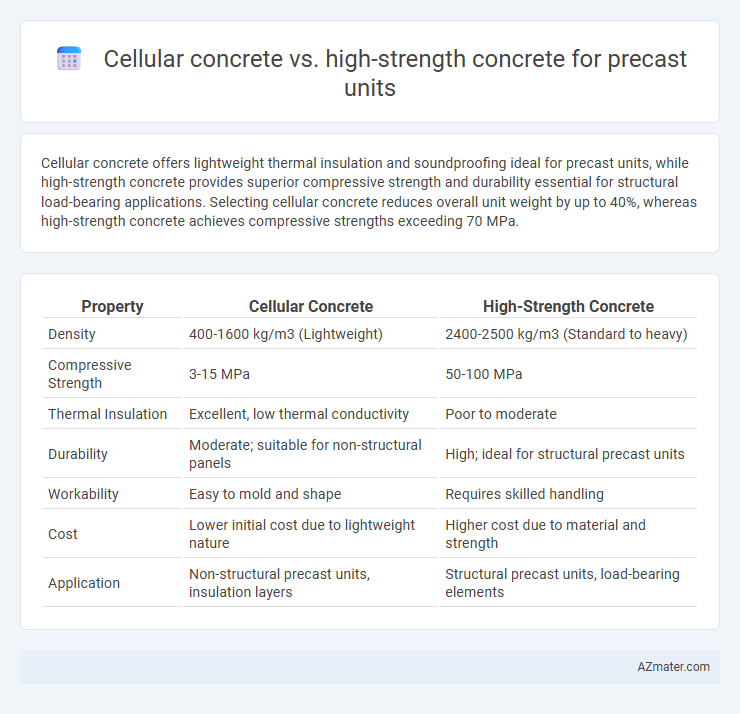Cellular concrete offers lightweight thermal insulation and soundproofing ideal for precast units, while high-strength concrete provides superior compressive strength and durability essential for structural load-bearing applications. Selecting cellular concrete reduces overall unit weight by up to 40%, whereas high-strength concrete achieves compressive strengths exceeding 70 MPa.
Table of Comparison
| Property | Cellular Concrete | High-Strength Concrete |
|---|---|---|
| Density | 400-1600 kg/m3 (Lightweight) | 2400-2500 kg/m3 (Standard to heavy) |
| Compressive Strength | 3-15 MPa | 50-100 MPa |
| Thermal Insulation | Excellent, low thermal conductivity | Poor to moderate |
| Durability | Moderate; suitable for non-structural panels | High; ideal for structural precast units |
| Workability | Easy to mold and shape | Requires skilled handling |
| Cost | Lower initial cost due to lightweight nature | Higher cost due to material and strength |
| Application | Non-structural precast units, insulation layers | Structural precast units, load-bearing elements |
Introduction to Precast Concrete Units
Precast concrete units are widely utilized in construction for their quality control and accelerated project timelines, with both cellular concrete and high-strength concrete serving distinct roles. Cellular concrete, known for its lightweight and insulating properties, enhances thermal performance and reduces structural load in precast panels. High-strength concrete offers superior compressive strength and durability, ideal for load-bearing and high-stress precast elements.
Overview of Cellular Concrete
Cellular concrete is a lightweight, aerated material composed of cement, water, and pre-formed foam, offering excellent thermal insulation and soundproofing properties for precast units. Its low density reduces structural load, enabling easier handling and faster installation compared to high-strength concrete, which is denser and designed primarily for compressive strength. Cellular concrete's versatility and sustainability make it a cost-effective alternative in non-load-bearing precast applications where energy efficiency and reduced weight are prioritized.
Overview of High-Strength Concrete
High-strength concrete (HSC) is characterized by its compressive strength exceeding 6,000 psi, making it ideal for precast units requiring enhanced durability and load-bearing capacity. It typically incorporates a lower water-cement ratio, high-performance admixtures, and supplementary cementitious materials like silica fume to achieve superior mechanical properties. Compared to cellular concrete, HSC offers greater density and structural integrity, enabling its use in demanding infrastructure and commercial precast applications.
Material Composition and Properties
Cellular concrete consists of cement, water, and pre-formed foam, resulting in a highly porous structure with low density and excellent thermal insulation, making it ideal for lightweight precast units. High-strength concrete uses a dense matrix of cement, fine and coarse aggregates, and admixtures to achieve compressive strengths typically above 50 MPa, offering superior load-bearing capacity for structural precast elements. While cellular concrete prioritizes reduced weight and thermal performance, high-strength concrete focuses on durability and mechanical strength in precast applications.
Weight and Density Comparison
Cellular concrete exhibits a significantly lower density, typically ranging from 400 to 1600 kg/m3, making it ideal for lightweight precast units that reduce structural load and improve thermal insulation. High-strength concrete, with densities around 2300 to 2500 kg/m3, offers superior compressive strength but results in heavier precast units, impacting transportation and installation costs. The lower weight of cellular concrete enhances ease of handling, whereas high-strength concrete precast units provide greater durability and load-bearing capacity.
Structural Performance and Load-Bearing Capacity
Cellular concrete exhibits lower density and reduced compressive strength compared to high-strength concrete, resulting in decreased load-bearing capacity suitable primarily for non-structural or lightweight precast units. High-strength concrete offers superior structural performance with compressive strengths often exceeding 50 MPa, enabling its use in load-bearing precast elements such as beams, columns, and slabs where high durability and minimal deflection are critical. The choice between cellular and high-strength concrete depends on the specific application, balancing weight reduction against required structural integrity and safety margins.
Thermal and Acoustic Insulation
Cellular concrete offers superior thermal insulation due to its lightweight, porous structure with air pockets that reduce heat transfer, making it ideal for energy-efficient precast units. High-strength concrete provides enhanced acoustic insulation through its dense matrix, effectively dampening sound transmission in building applications. Combining cellular concrete's thermal benefits with high-strength concrete's acoustic properties can optimize precast units for environments requiring both energy efficiency and noise control.
Durability and Lifespan in Precast Applications
Cellular concrete offers superior thermal insulation and lightweight properties but typically exhibits lower compressive strength and durability compared to high-strength concrete in precast applications. High-strength concrete provides enhanced durability with greater resistance to environmental degradation, chemical attack, and mechanical wear, leading to an extended lifespan in precast units exposed to severe conditions. The choice between cellular and high-strength concrete significantly impacts the long-term performance and maintenance requirements of precast structures.
Cost Considerations and Efficiency
Cellular concrete offers significant cost savings in precast units due to its lower density and reduced material usage, which results in decreased transportation and handling expenses. High-strength concrete, while more expensive per cubic meter, provides superior load-bearing capacity and durability, enabling thinner sections and potentially reducing overall project timelines. Evaluating the balance between initial material costs and long-term structural efficiency is critical for optimizing precast production cost-effectiveness.
Best Use Cases and Application Suitability
Cellular concrete offers exceptional thermal insulation and lightweight properties, making it ideal for precast units in non-load-bearing walls, soundproofing panels, and void filling applications where weight reduction is crucial. High-strength concrete is best suited for structural precast units such as beams, columns, and load-bearing walls that require superior compressive strength and durability under heavy loads. Selection depends on project-specific demands, balancing weight savings with structural performance to optimize precast unit efficiency and longevity.

Infographic: Cellular concrete vs High-strength concrete for Precast unit
 azmater.com
azmater.com